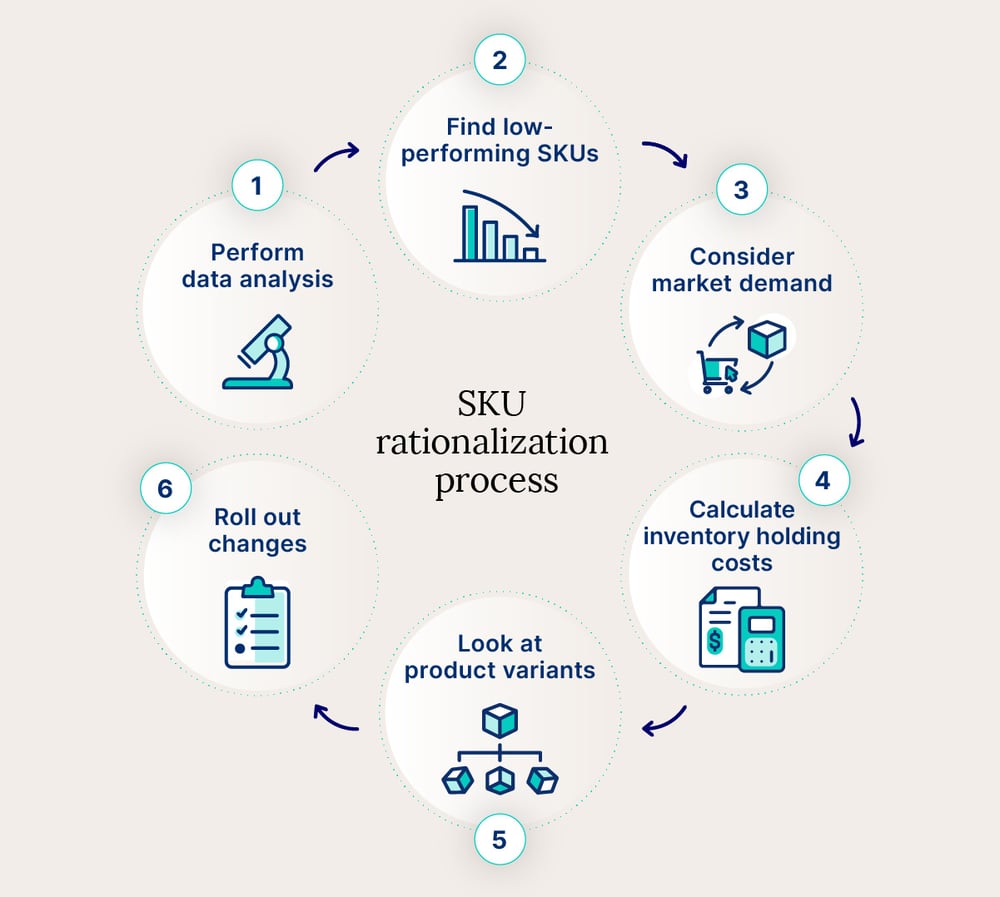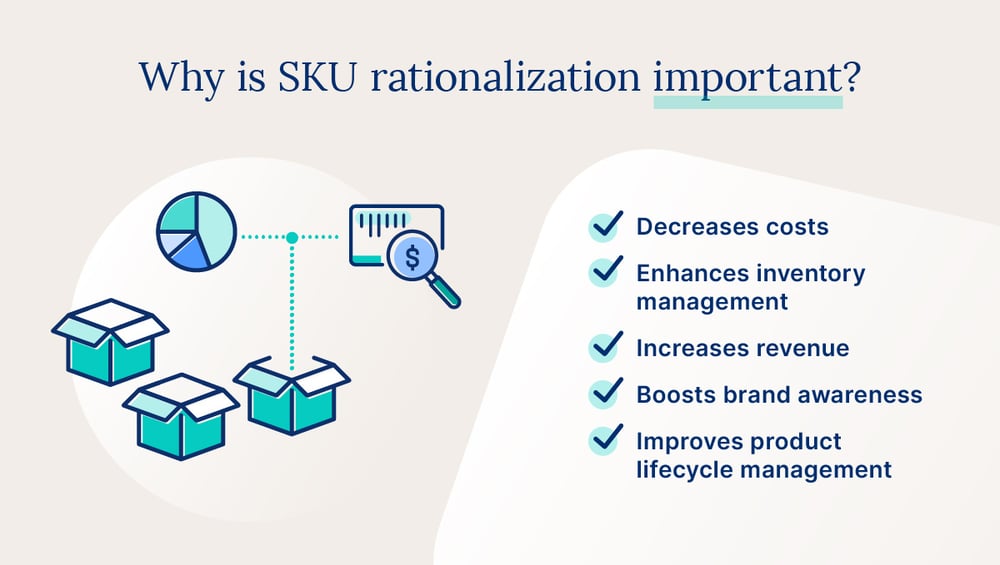What is SKU rationalization? Definition, benefits, and examples

Big corporations like Procter & Gamble and Unilever are getting better performance from their inventory through SKU rationalization, so much so that the process is now trending across companies of all sizes.
But what is an SKU? How do you even say it? SKU stands for “stock keeping unit” and is a unique code assigned to a product to identify and track information related to that product: price, product options (or variations), and manufacturer. It’s a string of numbers and letters that usually appears above a barcode. SKU can be pronounced like the word “skew” or like its letters spelled out.
Keep reading to learn more about how SKU rationalization works, examples, and benefits.

What is SKU rationalization?
SKU rationalization is an analytical process that evaluates the SKUs within a product portfolio to enhance operational efficiency, reduce costs, and ultimately improve overall business performance.
Organizations use SKU (or product) rationalization to decide which items to keep, restock, reduce, or eliminate from their inventory. This evaluation weighs the cost of producing and stocking against the benefit of selling each product and considers various factors like sales performance, market demand, production costs, and inventory management.
Rationalization, in short, frees companies to spend time and money on the products that work best. SKU rationalization is a kind of inventory optimization.

What is the meaning of SKU in retail?
First and foremost, tracking inventory using its SKU code helps inform retailer purchasing decisions about profitability. SKUs are also referenced to pick and pack orders and even make product suggestions to online shoppers. So, SKU inventory management can tell sellers and shoppers a lot.
SKU vs. UPC
What is the difference between a SKU and a UPC? Unlike universal product codes (UPCs), SKUs are not universal, meaning that each retailer has its own set of SKUs it assigns to its merchandise, generally to group items, categories, and subcategories together for analysis. That’s how sites like Amazon display similar items you might be interested in, based on the features indicated by that SKU meaning and other SKUs in the same category, sharing the same prefix.

Most POS systems allow you to create your own SKU inventory hierarchy based on what you want to track. For example, a shoe store would probably classify shoes first by customer type (men, women, or children), then style (dress or casual), color, and possibly material. A larger operation may choose to get even more granular to facilitate more detailed reporting, particularly if it carries many similar SKUs.
SKUs are used for inventory and sales tracking, meaning they help stores know which products are selling quickly and when items need reordering. Ultimately, this will determine the product mix, which is where SKU rationalization comes in.
SKU rationalization examples
For context on what SKU rationalization looks like in practice, here are three example scenarios.
Low-performing products
A retail company analyzes its extensive product catalog and identifies certain items that have consistently low sales over an extended period.
After evaluating the costs associated with producing and stocking these items, the company decides to discontinue or reduce the quantity of these low-performing SKUs to free up resources and shelf space for more profitable products.
Seasonal variations
A clothing manufacturer experiences fluctuations in demand for seasonal apparel. Through SKU rationalization, the company identifies clothing lines consistently in low demand during certain seasons.
Adjusting these items’ production and inventory levels helps minimize excess stock during off-seasons, reducing carrying costs and improving the inventory turnover ratio.
Product redundancy
A technology company that offers a range of similar electronic gadgets realizes that certain product models have overlapping features, resulting in customer confusion and internal complexity.
By conducting SKU rationalization, the company decides to consolidate its product line, eliminating redundant SKUs and focusing on those that offer unique features or cater to distinct market segments. This streamlining enhances clarity for customers and simplifies internal operations.
Benefits of SKU rationalization
From cutting costs to simplifying internal processes, SKU rationalization can have major impacts on your business. Here are five reasons why you should implement this strategic process.

Decreases costs
Getting rid of underperforming or redundant SKUs reduces costs from excess inventory and associated carrying costs. Streamlining the product lineup also helps a company optimize production, reduce storage expenses, and allocate resources more effectively.
Enhances inventory management
SKU rationalization makes it easier to maintain a more lean and focused inventory. This, in turn, helps improve inventory turnover rates, reduce the risk of overstocking or stockouts, and enhance overall supply chain efficiency. SKU rationalization generally contributes to a more agile inventory management system.
Increases revenue
By focusing on high-performing products, you can drive more revenue growth. This targeted approach helps you prioritize marketing efforts toward the most profitable products, meet market demands, and maximize revenue potential through improved customer satisfaction and strategic resource allocation.
Boosts brand awareness
When you refine your product portfolio, you can better align with your brand identity and resonate with your target audience. It helps you send a clearer and more compelling message since you have a more strategic focus. This improves consumer perception, making it easier for customers to associate the brand with high-quality items.
Improves product lifecycle management
This data-driven approach enables informed decisions about production, promotion, and discontinuation, ensuring resources are allocated effectively across various lifecycle stages.
By extending the lifecycle of successful products, introducing innovations, and phasing out products at the end of their cycle, businesses can implement a more adaptive product lifecycle management strategy.
From proliferation to SKU rationalization
There are more SKUs today than ever, especially in the retail sector. (Yes, suppliers use SKUs too!) As mentioned earlier, because they aren’t universal, vendors will have their own supplier SKU for any given item and will be interested in tracking different aspects of the supply chain than a retailer would. Scannable barcodes help vendors easily monitor inventory movement and can be used to track repairs, services, and warranties.
But back to the topic of retail. One report states that grocery stores, for example, carried 7,000 SKUs in 1970, a figure that soared to more than 31,000 by 2022. This “SKU boom” was the result of companies matching products to more particular customer preferences.
Variations, like a low-fat version of a food product or a limited-edition flavor, contribute to SKU proliferation, but so do shorter development cycles, which pile new inventory on top of old in anticipation of rapidly changing consumer tastes.
The challenge is that a higher number of SKUs can lead to higher inventory costs, specifically holding costs. If there isn’t sufficient demand for a specific SKU to go through inventory, the expenses incurred in maintaining that stock can result in an additional 15% to 40% of the product cost annually.
Brand rationalization
One of the world’s largest consumer goods providers, Unilever (think Dove and Axe body products), discontinued 17% of its SKUs in 2023.
This sort of brand rationalization can improve overall cash flow by lowering days inventory outstanding (DIO), which indicates the average number of days a company holds inventory before selling it. This ratio should be used to compare competitors over time. It’s also commonly referred to as days sales of inventory (DSI).
While rationalization is most commonly used in the retail and manufacturing industries, with tens of thousands of brands, products, and variations in their inventory, experts say it’s becoming a trend across companies of all sectors and sizes.
FAQ
What is the 80/20 rule for SKU rationalization?
The 80/20 rule for SKU rationalization, also known as the Pareto principle, suggests that about 80% of a company’s sales come from 20% of its products. This principle implies that businesses should focus on optimizing their most profitable and high-performing products to achieve efficiency and cost-saving benefits.
Is product rationalization the same as SKU rationalization?
Product rationalization typically involves evaluating entire product lines, including variations, while SKU rationalization specifically focuses on individual SKUs within those product lines. In essence, SKU rationalization is a more granular approach within the greater context of product rationalization.
What is an SKU strategy?
An SKU strategy is a deliberate approach businesses adopt in managing their SKUs. It involves decisions on product assortment, production, stocking levels, and marketing efforts. These decisions aim to align with market demand, optimize resources, and maximize overall efficiency and profitability within the context of the company’s broader business strategy.
Use Cin7 for SKU rationalization
An integrated system like Cin7 Core or Cin7 Omni can provide automated processes and real-time inventory visibility that make SKU rationalization easier. Inventory management software can help you analyze your sales data to increase cash flow and allocate more resources to high-performing products.
Request a demo today to see how the right system can help streamline your business.
More from the blog
View All Posts
The definitive guide to stocktaking
Read More
Christmas in July: Preparing for Q4 sales
Read More




